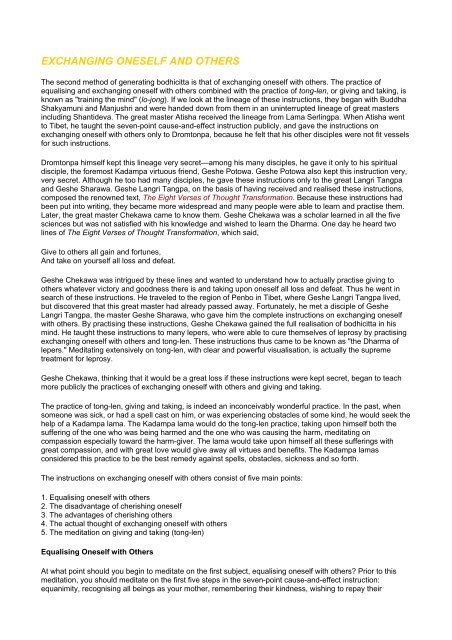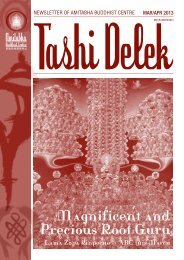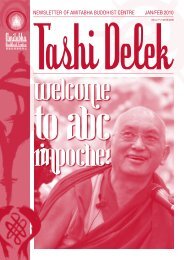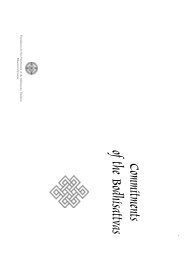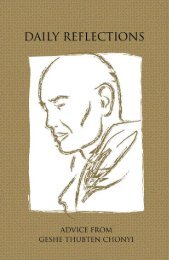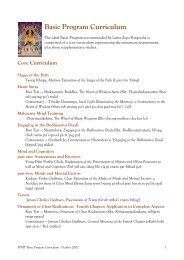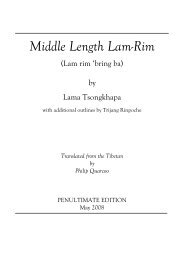How to Generate Bodhicitta (English) - Amitabha Buddhist Centre
How to Generate Bodhicitta (English) - Amitabha Buddhist Centre
How to Generate Bodhicitta (English) - Amitabha Buddhist Centre
You also want an ePaper? Increase the reach of your titles
YUMPU automatically turns print PDFs into web optimized ePapers that Google loves.
EXCHANGING ONESELF AND OTHERSThe second method of generating bodhicitta is that of exchanging oneself with others. The practice ofequalising and exchanging oneself with others combined with the practice of <strong>to</strong>ng-len, or giving and taking, isknown as "training the mind" (lo-jong). If we look at the lineage of these instructions, they began with BuddhaShakyamuni and Manjushri and were handed down from them in an uninterrupted lineage of great mastersincluding Shantideva. The great master Atisha received the lineage from Lama Serlingpa. When Atisha went<strong>to</strong> Tibet, he taught the seven-point cause-and-effect instruction publicly, and gave the instructions onexchanging oneself with others only <strong>to</strong> Drom<strong>to</strong>npa, because he felt that his other disciples were not fit vesselsfor such instructions.Drom<strong>to</strong>npa himself kept this lineage very secret—among his many disciples, he gave it only <strong>to</strong> his spiritualdisciple, the foremost Kadampa virtuous friend, Geshe Po<strong>to</strong>wa. Geshe Po<strong>to</strong>wa also kept this instruction very,very secret. Although he <strong>to</strong>o had many disciples, he gave these instructions only <strong>to</strong> the great Langri Tangpaand Geshe Sharawa. Geshe Langri Tangpa, on the basis of having received and realised these instructions,composed the renowned text, The Eight Verses of Thought Transformation. Because these instructions hadbeen put in<strong>to</strong> writing, they became more widespread and many people were able <strong>to</strong> learn and practise them.Later, the great master Chekawa came <strong>to</strong> know them. Geshe Chekawa was a scholar learned in all the fivesciences but was not satisfied with his knowledge and wished <strong>to</strong> learn the Dharma. One day he heard twolines of The Eight Verses of Thought Transformation, which said,Give <strong>to</strong> others all gain and fortunes,And take on yourself all loss and defeat.Geshe Chekawa was intrigued by these lines and wanted <strong>to</strong> understand how <strong>to</strong> actually practise giving <strong>to</strong>others whatever vic<strong>to</strong>ry and goodness there is and taking upon oneself all loss and defeat. Thus he went insearch of these instructions. He traveled <strong>to</strong> the region of Penbo in Tibet, where Geshe Langri Tangpa lived,but discovered that this great master had already passed away. Fortunately, he met a disciple of GesheLangri Tangpa, the master Geshe Sharawa, who gave him the complete instructions on exchanging oneselfwith others. By practising these instructions, Geshe Chekawa gained the full realisation of bodhicitta in hismind. He taught these instructions <strong>to</strong> many lepers, who were able <strong>to</strong> cure themselves of leprosy by practisingexchanging oneself with others and <strong>to</strong>ng-len. These instructions thus came <strong>to</strong> be known as "the Dharma oflepers." Meditating extensively on <strong>to</strong>ng-len, with clear and powerful visualisation, is actually the supremetreatment for leprosy.Geshe Chekawa, thinking that it would be a great loss if these instructions were kept secret, began <strong>to</strong> teachmore publicly the practices of exchanging oneself with others and giving and taking.The practice of <strong>to</strong>ng-len, giving and taking, is indeed an inconceivably wonderful practice. In the past, whensomeone was sick, or had a spell cast on him, or was experiencing obstacles of some kind, he would seek thehelp of a Kadampa lama. The Kadampa lama would do the <strong>to</strong>ng-len practice, taking upon himself both thesuffering of the one who was being harmed and the one who was causing the harm, meditating oncompassion especially <strong>to</strong>ward the harm-giver. The lama would take upon himself all these sufferings withgreat compassion, and with great love would give away all virtues and benefits. The Kadampa lamasconsidered this practice <strong>to</strong> be the best remedy against spells, obstacles, sickness and so forth.The instructions on exchanging oneself with others consist of five main points:1. Equalising oneself with others2. The disadvantage of cherishing oneself3. The advantages of cherishing others4. The actual thought of exchanging oneself with others5. The meditation on giving and taking (<strong>to</strong>ng-len)Equalising Oneself with OthersAt what point should you begin <strong>to</strong> meditate on the first subject, equalising oneself with others? Prior <strong>to</strong> thismeditation, you should meditate on the first five steps in the seven-point cause-and-effect instruction:equanimity, recognising all beings as your mother, remembering their kindness, wishing <strong>to</strong> repay their


